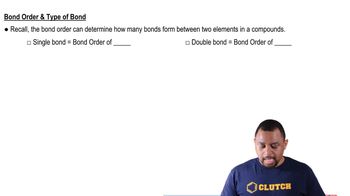Here are the essential concepts you must grasp in order to answer the question correctly.
Electron-Dot Structure
An electron-dot structure, or Lewis structure, represents the valence electrons of atoms within a molecule. In this diagram, dots are used to illustrate the bonding between atoms and the presence of lone pairs. For nitrogen (N2), the structure shows a triple bond between the two nitrogen atoms, indicating that they share three pairs of electrons, which contributes to the molecule's stability.
Recommended video:
Lewis Dot Structures: Ions
Triple Bond
A triple bond occurs when two atoms share three pairs of electrons, resulting in a strong bond. In the case of N2, the triple bond between the nitrogen atoms is very strong due to the effective overlap of their p-orbitals. This strong bonding interaction makes the molecule less likely to react with other substances, as breaking the triple bond requires a significant amount of energy.
Recommended video:
Bond Order and Type of Bond
Molecular Stability and Reactivity
Molecular stability refers to the tendency of a molecule to maintain its structure without undergoing chemical change. N2 is particularly unreactive due to its strong triple bond and the lack of available lone pairs for bonding with other atoms. This stability is a key reason why nitrogen gas is inert under standard conditions, making it a common filler gas in various applications.
Recommended video:
Intepreting the Band of Stability
 Verified step by step guidance
Verified step by step guidance

